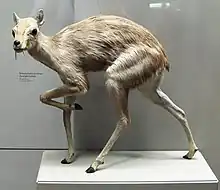Micromeryx
Micromeryx is an extinct genus of musk deer that lived during the Miocene epoch (about 16-8 million years ago).[3] Fossil remains were found in Europe and Asia.[4] The earliest record (MN4) of the genus comes from the Sibnica 4 paleontological site near Rekovac in Serbia.[3]
| Micromeryx Temporal range: | |
|---|---|
 | |
| Male Micromeryx skeleton, Museum am Löwentor, Stuttgart, Germany | |
| Scientific classification | |
| Domain: | Eukaryota |
| Kingdom: | Animalia |
| Phylum: | Chordata |
| Class: | Mammalia |
| Order: | Artiodactyla |
| Family: | Moschidae |
| Genus: | †Micromeryx Lartet, 1851 |
| Species | |
|
M. flourensianus Lartet 1851 | |

Characteristics
This animal was very similar to the modern musk deer (Moschus moschiferus) of East Asia. However, Micromeryx (its name means "tiny ruminant") was much smaller: it perhaps reached 5 kilograms. Teeth were very similar to those of the extant Cephalophus but more primitive. Like in the present moschids, the males of these animals were equipped with long upper canines, protruding from the mouth when it was closed. The body was slender and short, while the legs were extremely elongated.[4]
Systematics
Micromeryx was a primitive representative of the moschids, a group of primitive ruminants related to deer and cattle. They had a remarkable expansion during the Miocene and Pliocene and are currently represented by a few species, such as the aforementioned Moschus moschiferus. Micromeryx probably originated in Western Asia and then spread to Europe and East Asia. Many fossils of this animal have been found in a vast geographical area ranging from Anatolia (Turkey) to Spain and China. A somewhat similar animal was Hispanomeryx, which lived in about the same area but went extinct during the middle Miocene.[4]
References
- Manuela Aiglstorfer, Loïc Costeur, Bastien Mennecart, Elmar P. J. Heizmann: Micromeryx? eiselei — A new moschid species from Steinheim am Albuch, Germany, and the first comprehensive description of moschid cranial material from the Miocene of Central Europe, in: PLOS One vom 16. Oktober 2017, DOI: 10.1371/journal.pone.0185679
- Aiglstorfer at al.: 3D models related to the publication: Micromeryx? eiselei - a new moschid species from Steinheim am Albuch, Germany, and the first comprehensive description of moschid cranial material from the Miocene of Central Europe, PDF
- Mennecart, Bastien; Aiglstorfer, Manuela; Göhlich, Ursula; Daxner-Höck, Gudrun (2019). "On the oldest Mongolian moschids (Mammalia, Ruminantia) and the early moschid evolution". Palaeontologia Electronica. 22 (2): 1–17. doi:10.26879/959.
- Sánchez, I. M.; Morales, J. (2008). "Micromeryx azanzae sp. nov. (Ruminantia: Moschidae) from the middle-upper Miocene of Spain, and the first description of the cranium of Micromeryx". Journal of Vertebrate Paleontology. 28 (3): 873–885. doi:10.1671/0272-4634(2008)28[873:MASNRM]2.0.CO;2.
Further reading
- Sánchez, I. M., and J. Morales. 2006. Distributión biocronológica de los Moschidae (Mammalia; Ruminantia) en España. Estudios Geológicos 62:533–546.